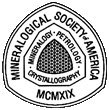 |
The Mineral Identification Key |  |
 |
The Mineral Identification Key |  |
Table IA: Minerals with Metallic or Submetallic Luster & Hardness of less than 2½: (Will readily leave a mark on paper.) [Next Table]
| Hardness | Color | Streak | Cleavage | Name | System | Habit | SG | Notes |
| 1+ | Dark-red to Vermilion | Rust-red | HEMATITE Fe2O3 |
Trigonal | Ocherous masses, granular, often as a pigment – "rust" – in rocks | 5.2 | Exhibits a wide range of hardness depending on form; crystalline hematite is harder. | |
| 1 to 1½ | Steel-grey to Iron-black | Black | One perfect direction (basal) | GRAPHITE C |
Trigonal | May be in small hexagonal plates | 2.23 | Has a greasy feel. |
| 1 to 1½ | Bluish-black | Black to Greenish-black | One perfect direction (basal) | MOLYBDENITE MoS2 | Trigonal | Usually in somewhat foliated appearing masses, often leaf-like hexagonal plate | 4.7 | Has a greasy feel; heavier than graphite |
| Hardness | Color | Streak | Cleavage | Name | System | Habit | SG | Notes |
| 1 to 2 | Iron-black | Black | One perfect direction | PYROLUSITE MnO2 |
Tetragonal | May be splintery or in radiating fibrous masses | 4.7 | Sometimes won’t mark paper. Most dendrites are not pyrolusite. |
| 1½ | Lead-grey | Lead-grey | One perfect direction | NAGYÁGITE Pb5Au(Te,Sb)4S5-8 |
Orthorhombic pseudo- tetragonal |
Usually platy masses, may be granular | 7.4 to 7.5 | Flakes flexible. Rare. |
| 1½ | Steel-grey | Steel-grey | One perfect direction | TETRADYMITE Bi2Te2S |
Trigonal | Usually in foliated to bladed masses, acute rhombohedral crystals rare | 7.1 to 7.4 | Flexible. Relatively rare. |
| 1½ to 2 | Silvery-white | Grey | SYLVANITE (Au,Ag)2Te4 |
Monoclinic | Usually granular or in bladed aggregates, often appears as skeletal forms on rocks, resembling writing (cuneiform). | 8 to 8.2 | May not mark paper. Rare. | |
| Hardness | Color | Streak | Cleavage | Name | System | Habit | SG | Notes |
| 2 | Grey-black to Lead-grey | Black to Grey-black | One perfect direction, two imperfect | BISMUTHINITE Bi2S3 | Orthorhombic | In bladed crystals showing cross striations | 6.78 | Similar to stibnite but heavier. Rare |
| 2 | Grey-black | Bluish-black to Silvery-black | One perfect direction (prismatic), two imperfect | STIBNITE Sb2S3 |
Orthorhombic | Usually as thick bladed crystals with striations both parallel to and across the long axis; crystals often bent or "kinked" | 4.5 | Fuses in a candle flame, sometimes won’t mark paper. |
| 2 to 2½ | Grey-black to Lead-grey | Black | ACANTHITE Ag2S |
Isometric | Pseudo-cubic, usually massive | 7.3 | Bright-steel-grey on fresh surfaces but darkens upon exposure, easily cut with a knife (sectile). Sometimes won’t mark paper | |
| 2 to 2½ | Iron-black | Iron-black | STEPHANITE Ag5SbS4 |
Orthorhombic | Usually massive, more rarely as short prismatic to tabular crystals | 6.2 to 6.5 | Rare | |
| Hardness | Color | Streak | Cleavage | Name | System | Habit | SG | Notes |
| 2 to 2½ | Bright-red | Bright-red to Deep-red | One perfect direction | CINNABAR HgS |
Trigonal | Usually in granular masses | 8.1 | Luster actually adamantine, sometimes appearing sub-metallic to metallic. May not mark paper. |
| 2 to 2½ | Brownish-red to Scarlet or Vermilion | Deep Ruby-red to Bright Ruby-red | One distinct direction | PYRARGYRITE/
PROUSTITE
Ag3(Sb,As)S3 Ag3(As,Sb)S3 |
Trigonal | Prismatic, pyramidal, rhombohedral, and scalenohedral crystals , also massive, usually as complex intergrown crystal aggregates | 5.57 to 5.58 | Isostructural species difficult to distinguish, though pyrargyrite is usually darker in color and more common than proustite. Rare. |
| 2 to 2½ | Silvery-white | Silvery-white with decidedly reddish tones | One perfect direction (basal), one good | BISMUTH Bi |
Trigonal | Usually in laminated granular masses, may be arborescent or reticulated, artificial crystals in pseudo-cubic "hopper" groups | 9.8 | Heavy. Rare. May not mark paper. |
| Hardness | Color | Streak | Cleavage | Name | System | Habit | SG | Notes |
| 2½ | Brass-yellow to Silvery-white | Yellowish- to Greenish-grey | CALAVERITE AuTe2 |
Monoclinic | Usually granular, rarely in distinct elongated crystals | 9.35 | Very heavy, easily fusible in candle flame (leaving globules of gold). (May not mark paper.) Rare. | |
| 2½ | Grey-black to Black | Bluish-black to Lead-grey | Perfect in three directions at 90o to each other | GALENA PbS |
Isometric | Usually in cubic crystals or masses exhibiting cubic cleavage, also in granular masses. | 7.6 | Sometimes won’t mark paper |
| 2 to 3 | Black | Black | One imperfect direction | POLYBASITE (Ag,Cu)16Sb2S11 |
Monoclinic, pseudo- hexagonal |
Usually massive or in crude pseudo-hexagonal plates | 6.1 to 6.2 | Rare |
[ Table of Contents ] [ Introduction ] [ Identification Kit ] [ Mineral Properties ] [ Environments & Associations ] [ In Conclusion ] [ The Mineral ID Key ]
[Previous] [
Next Table]